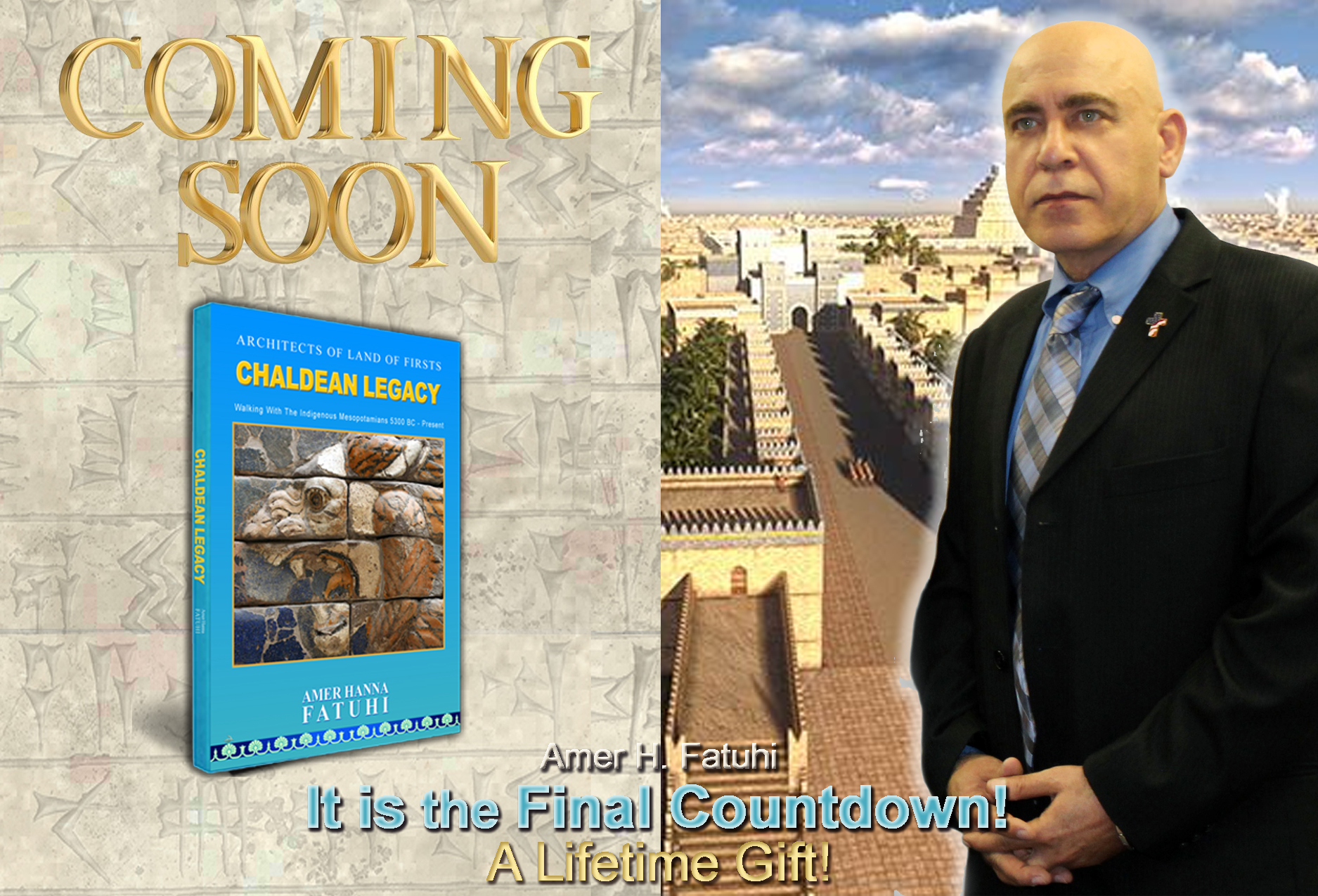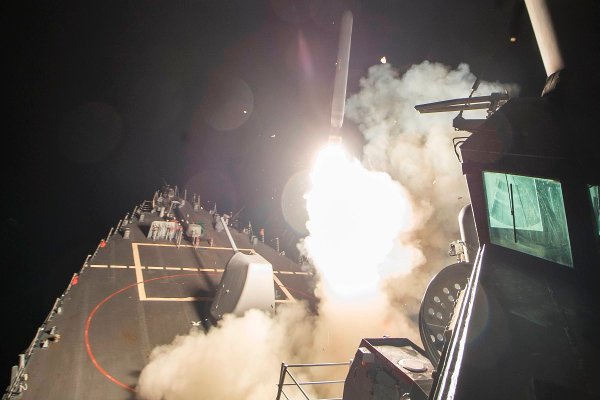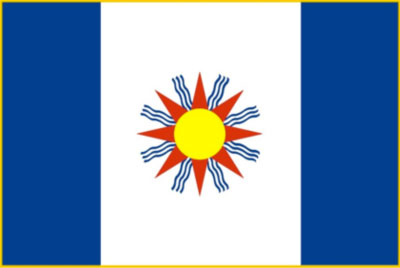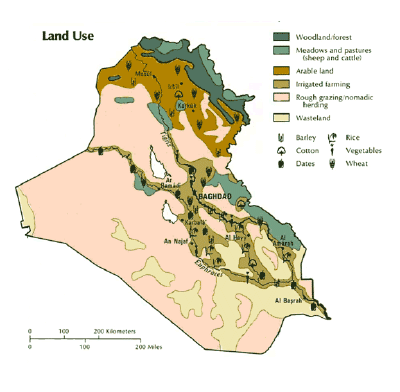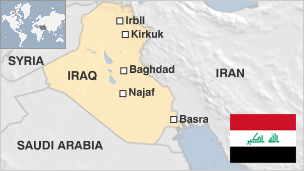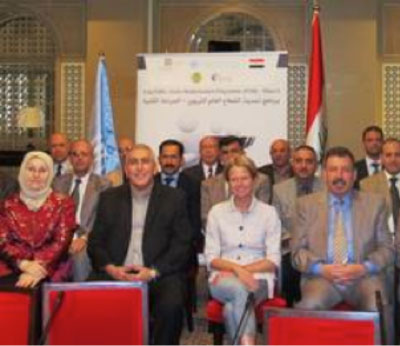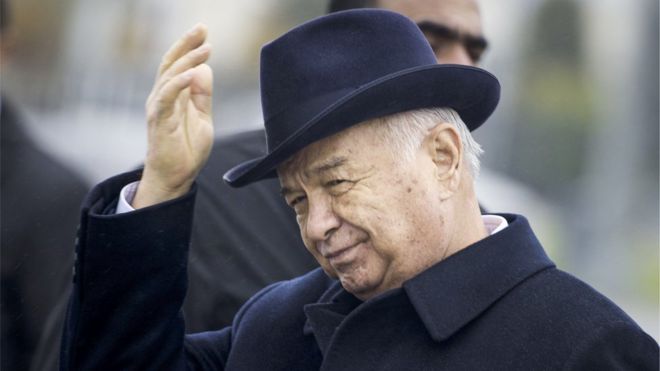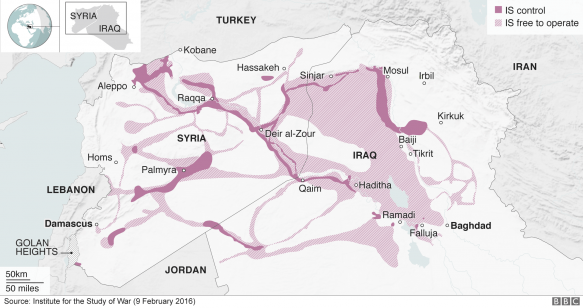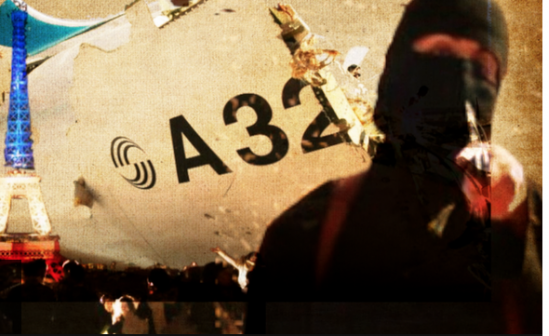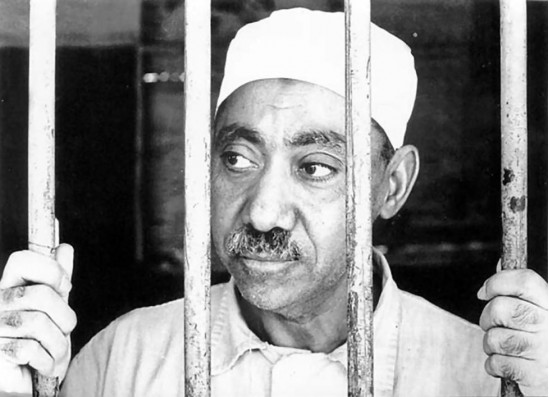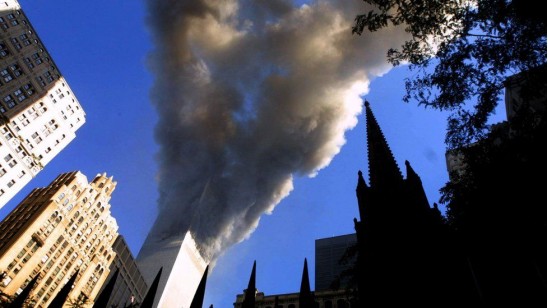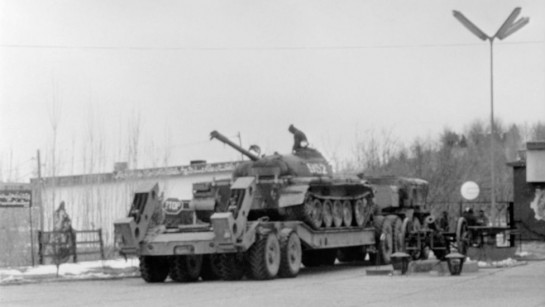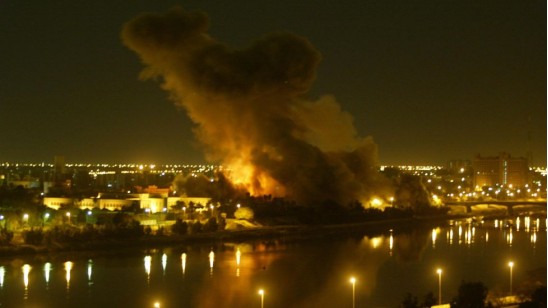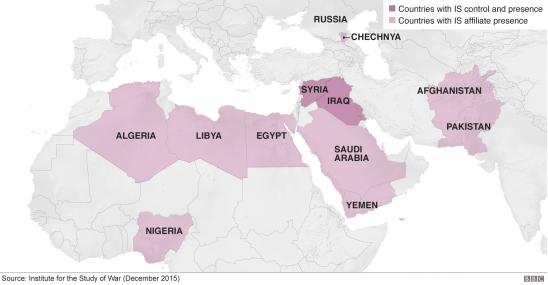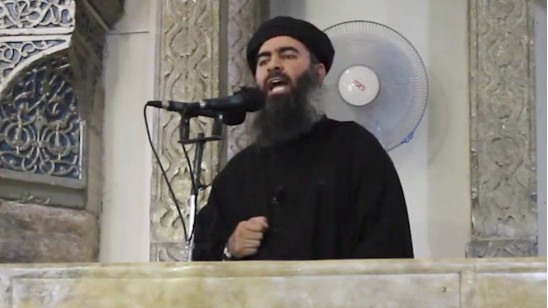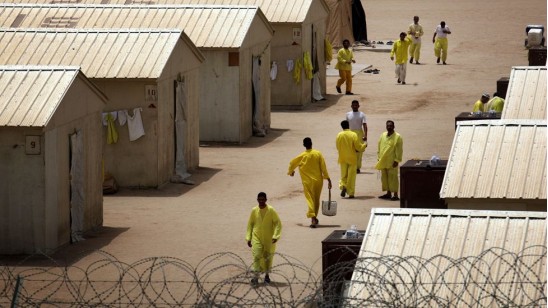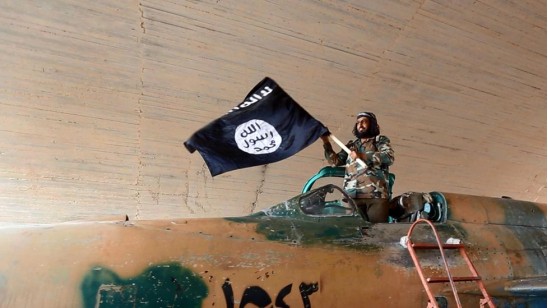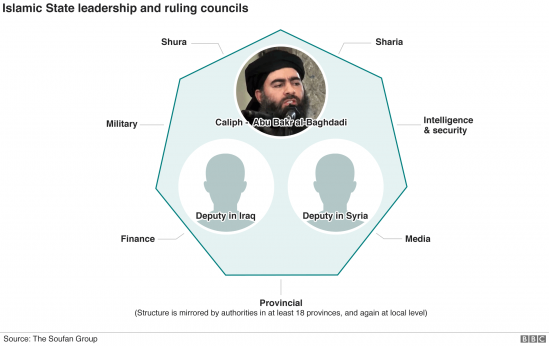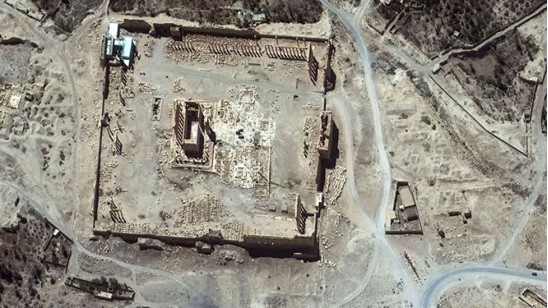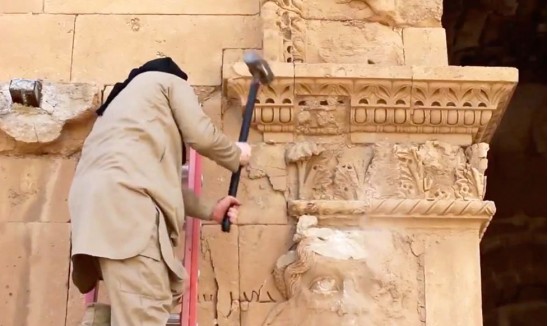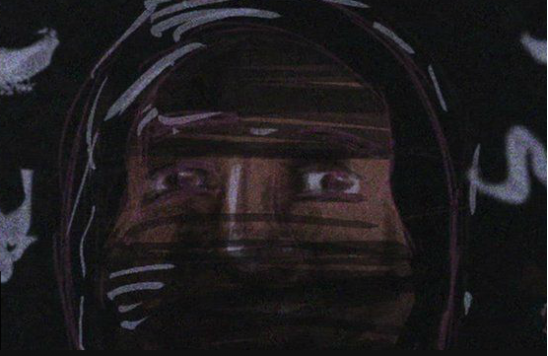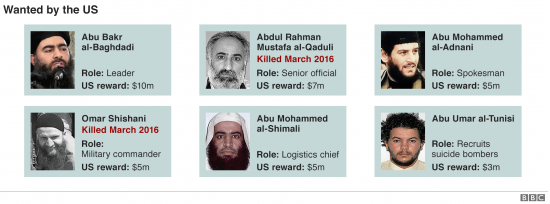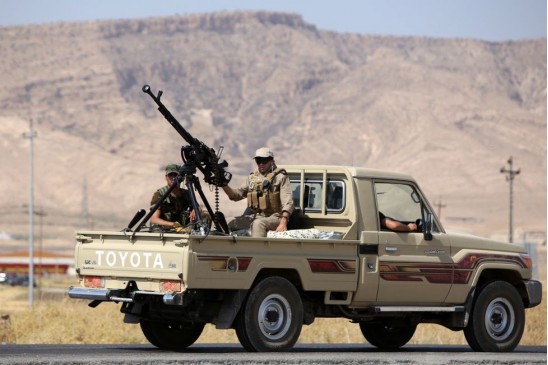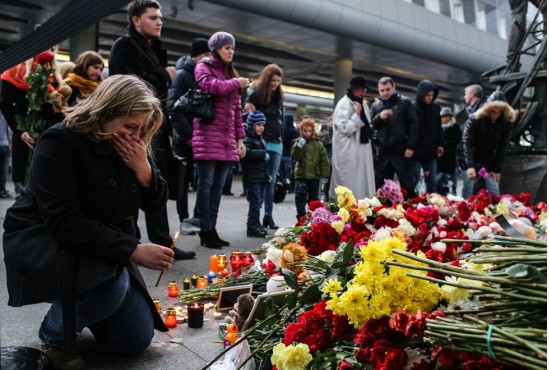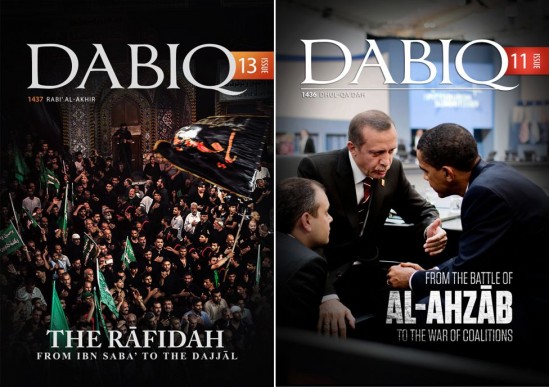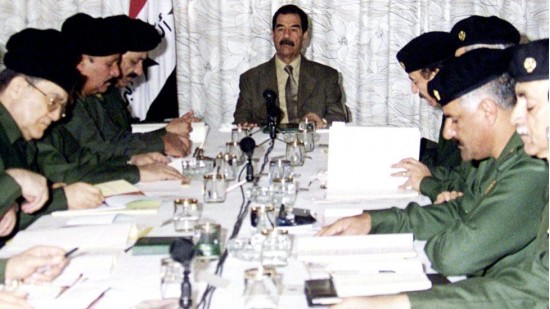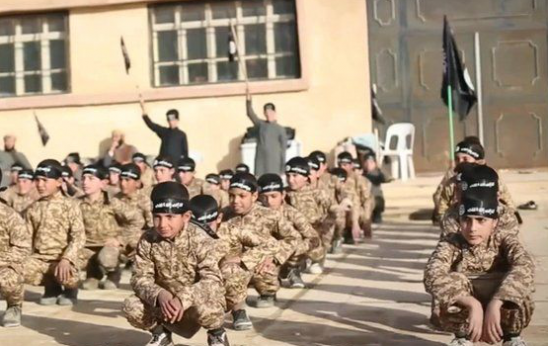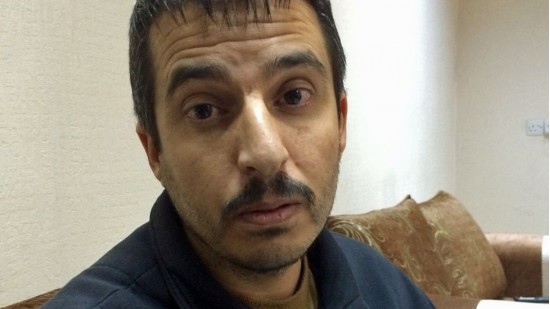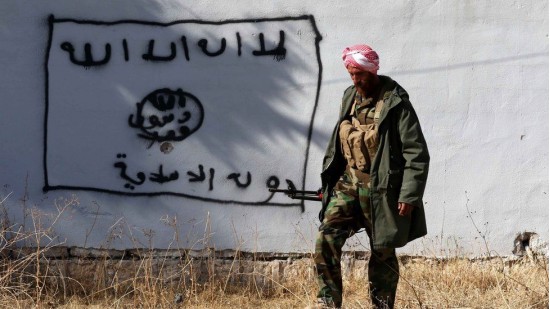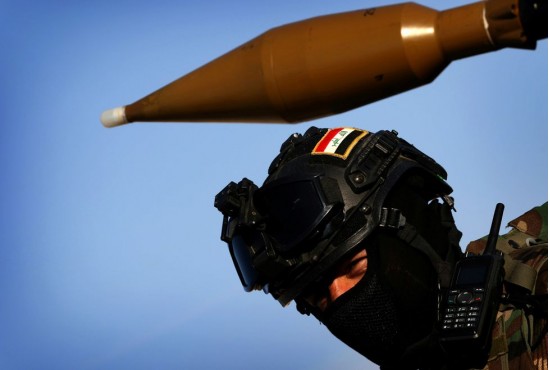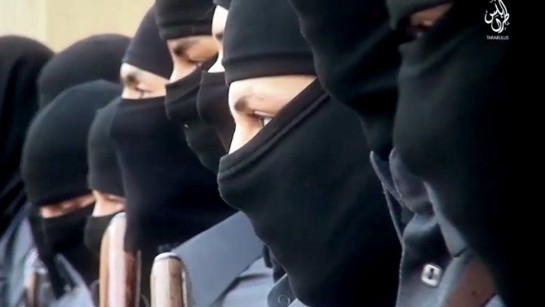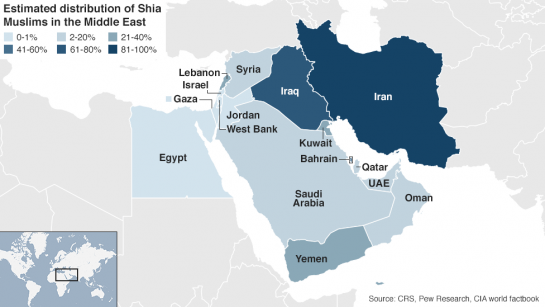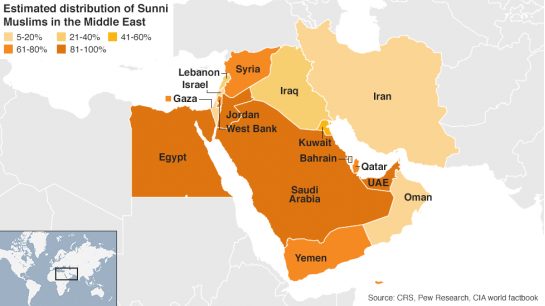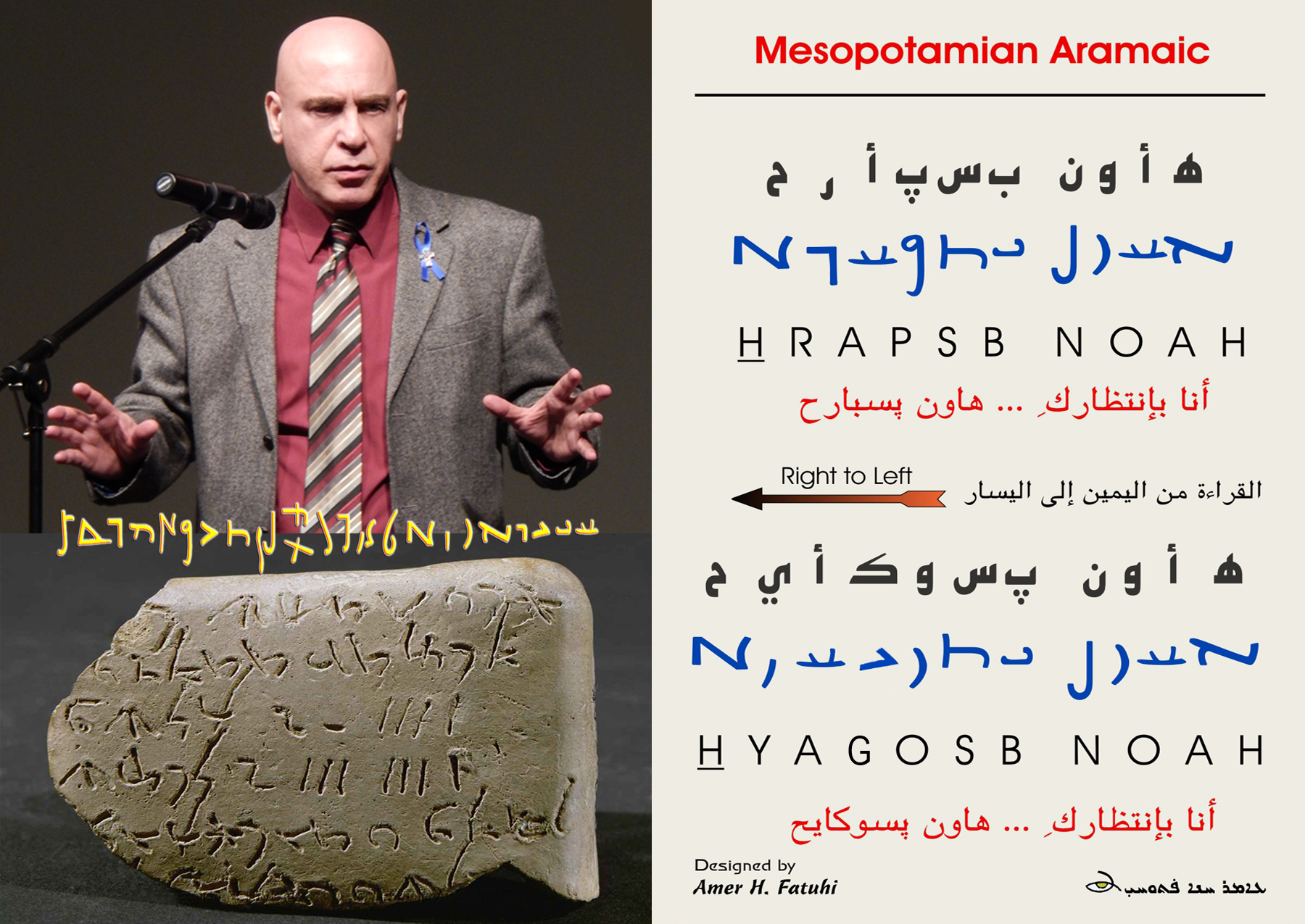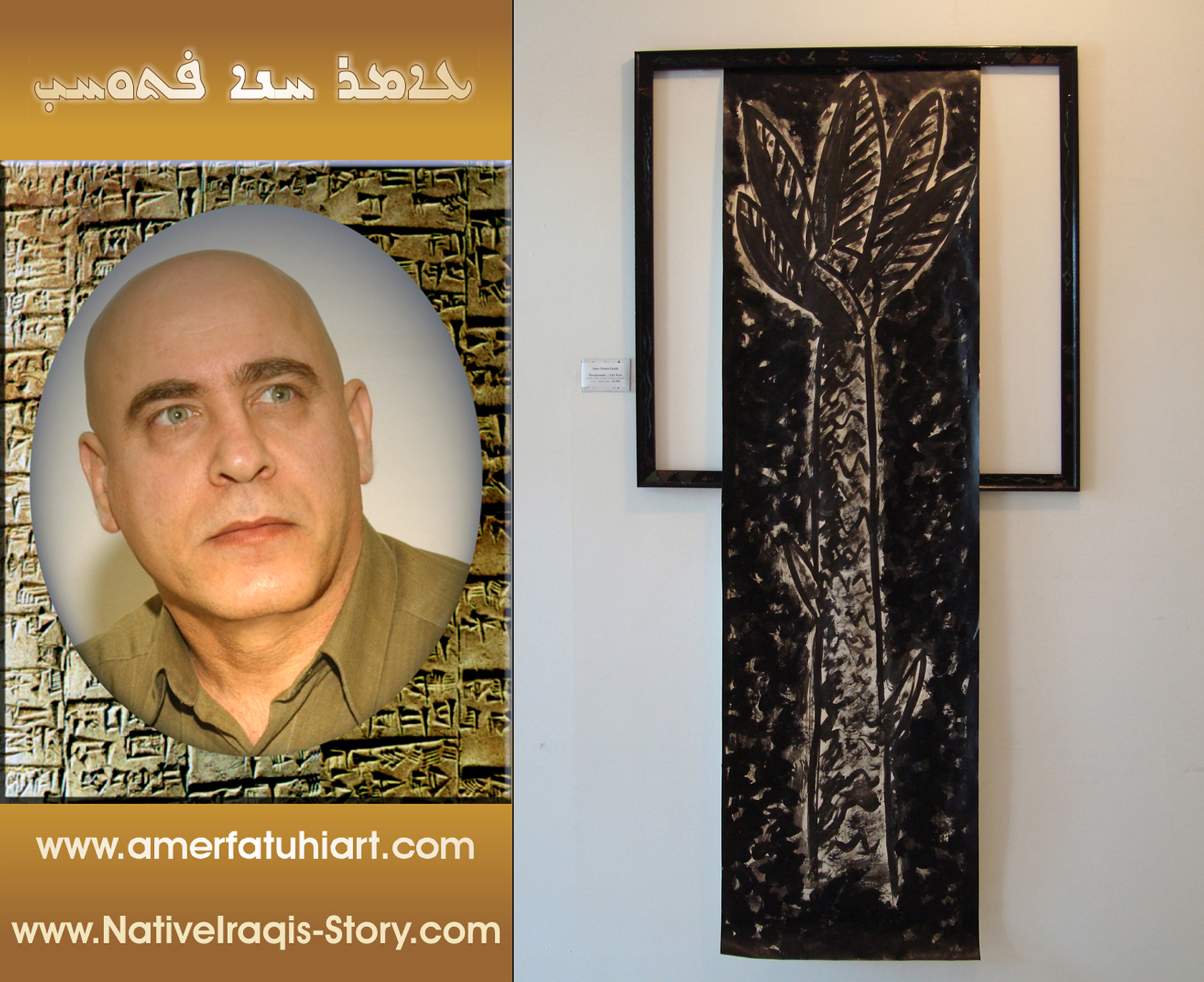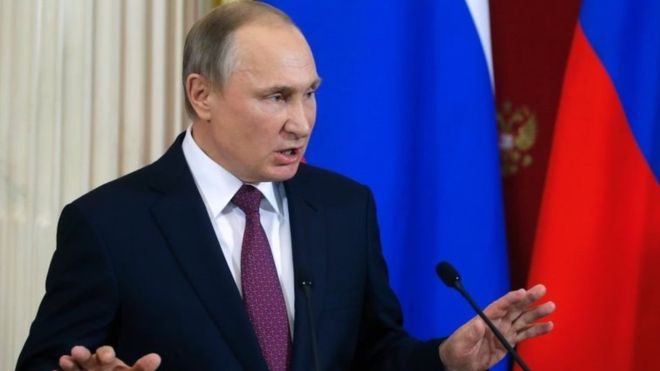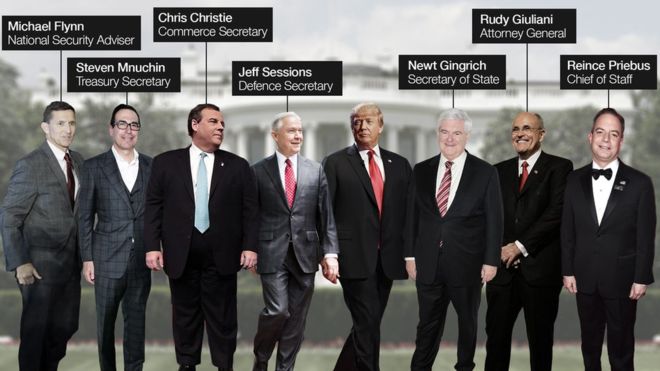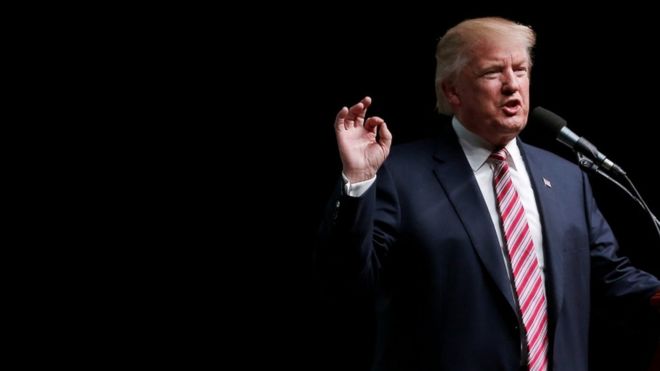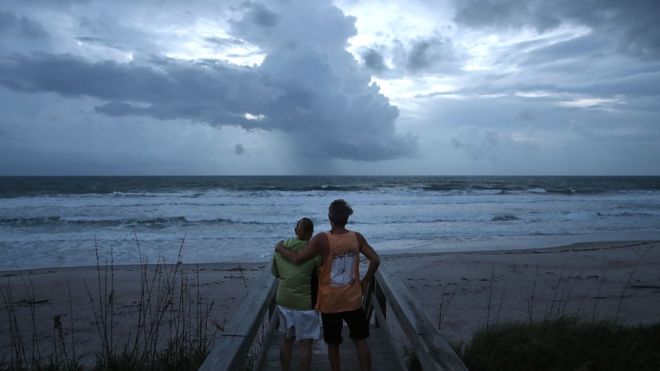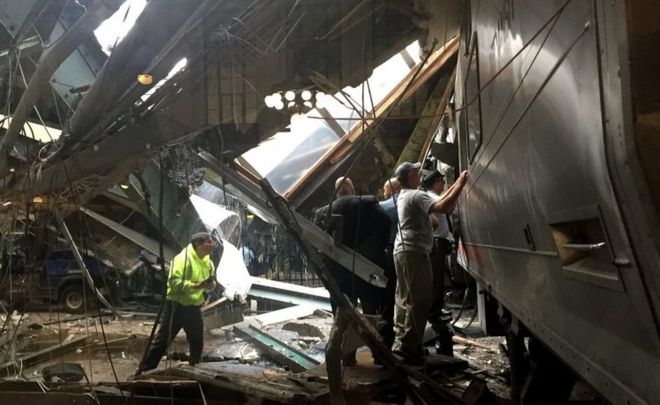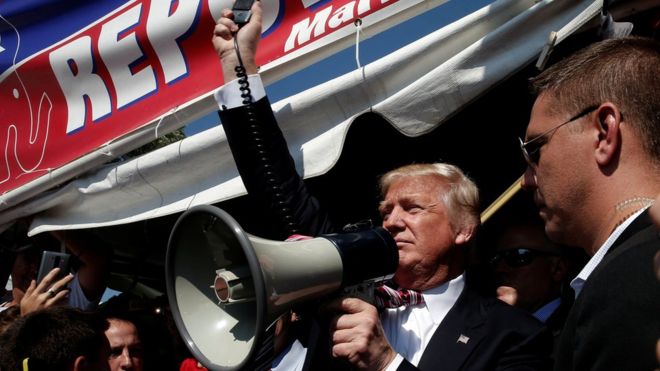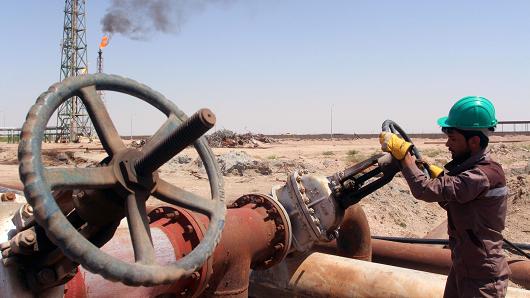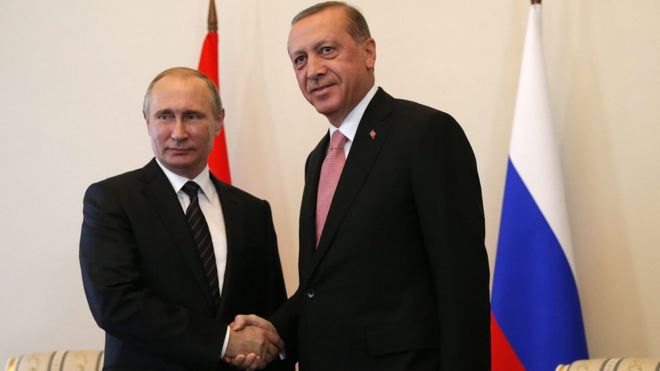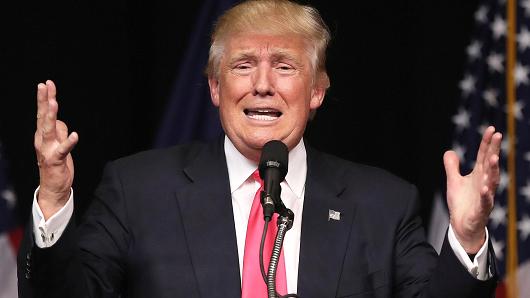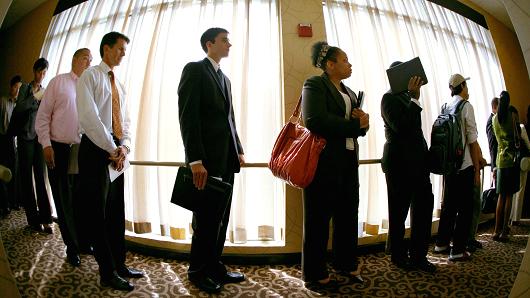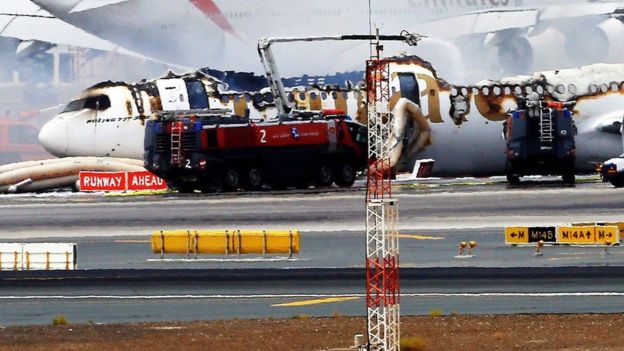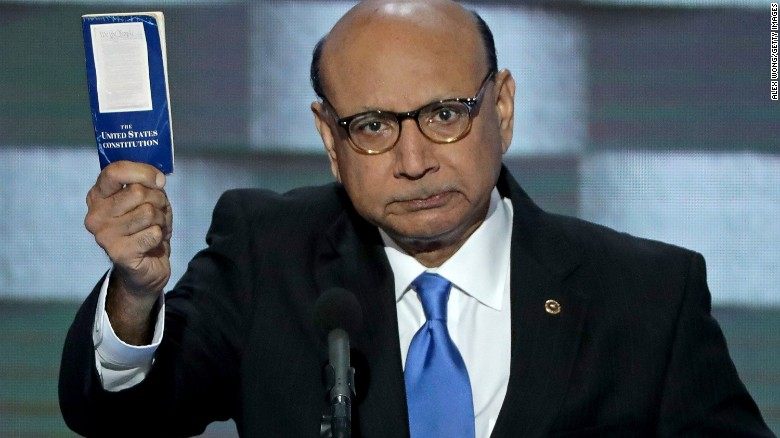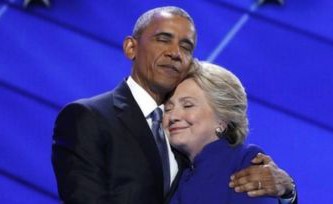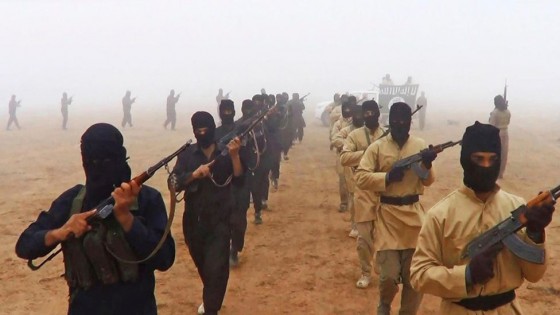 Abu Anis only realised something unusual was happening when he heard the sound of explosions coming from the old city on the western bank of the Tigris as it runs through Mosul.
Abu Anis only realised something unusual was happening when he heard the sound of explosions coming from the old city on the western bank of the Tigris as it runs through Mosul.
By Jim Muir
BBC News
"I phoned some friends over there, and they said armed groups had taken over, some of them foreign, some Iraqis," the computer technician said. "The gunmen told them, 'We've come to get rid of the Iraqi army, and to help you.'"
The following day, the attackers crossed the river and took the other half of the city. The Iraqi army and police, who vastly outnumbered their assailants, broke and fled, officers first, many of the soldiers stripping off their uniforms as they joined a flood of panicked civilians.
It was 10 June 2014, and Iraq's second biggest city, with a population of around two million, had just fallen to the militants of the group then calling itself Islamic State in Iraq and al-Sham/the Levant (Isis or Isil).
Four days earlier, black banners streaming, a few hundred of the Sunni militants had crossed the desert border in a cavalcade from their bases in eastern Syria and met little resistance as they moved towards their biggest prize.
Rich dividends were immediate. The Iraqi army, rebuilt, trained and equipped by the Americans since the US-led invasion of 2003, abandoned large quantities of armoured vehicles and advanced weaponry, eagerly seized by the militants. They also reportedly grabbed something like $500m from the Central Bank's Mosul branch.
How rich is IS?
Despite territorial losses, IS survives, thanks in no small part to its status as "the best-funded terrorist organisation" in history. While most people decry the validity inferred from the name of IS as a "state", the group's financing is certainly more reminiscent of a state than that of organisations such as al-Qaeda that relied heavily on donations to fund their operations.
Islamic State: The struggle to stay rich
"At the beginning, they behaved well," said Abu Anis. "They took down all the barricades the army had put up between quarters. People liked that. On their checkpoints they were friendly and helpful - 'Anything you need, we're here for you.'"
The Mosul honeymoon was to last a few weeks. But just down the road, terrible things were already happening.
As the Iraqi army collapsed throughout the north, the militants moved swiftly down the Tigris river valley. Towns and villages fell like skittles. Within a day they had captured the town of Baiji and its huge oil refinery, and moved on swiftly to seize Saddam Hussein's old hometown, Tikrit, a Sunni hotbed.
Just outside Tikrit is a big military base, taken over by the Americans in 2003 and renamed Camp Speicher after the first US casualty in the 1991 "Desert Storm" Gulf war against Iraq, a pilot called Scott Speicher, shot down over al-Anbar province in the west.
Camp Speicher, by now full of Iraqi military recruits, was surrounded by the Isis militants and surrendered. The thousands of captives were sorted, the Shia were weeded out, bound, and trucked away to be systematically shot dead in prepared trenches. Around 1,700 are believed to have been massacred in cold blood. The mass graves are still being exhumed.
Far from trying to cover up the atrocity, Isis revelled in it, posting on the internet videos and pictures showing the Shia prisoners being taken away and shot by the black-clad militants.
In terms of exultant cruelty and brutality, worse was not long in coming.
After a pause of just two months, Isis - now rebranded as "Islamic State" (IS) - erupted again, taking over large areas of northern Iraq controlled by the Kurds.
That included the town of Sinjar, mainly populated by the Yazidis, an ancient religious minority regarded by IS as heretics.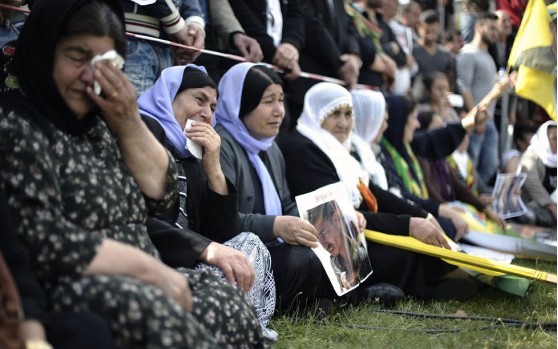
Hundreds of Yazidi men who failed to escape were simply killed. Women and children were separated and taken away as war booty, to be sold and bartered as chattels, and used as sex slaves. Thousands are still missing, enduring that fate.
Deliberately shocking, bloodthirsty exhibitionism reached a climax towards the end of the same month, August 2014.
IS issued a video showing its notorious, London-accented and now late executioner Mohammed Emwazi (sardonically nicknamed "Jihadi John" by former captives) gruesomely beheading American journalist James Foley.
In the following weeks, more American and British journalists and aid workers - Steven Sotloff, David Haines, Alan Henning, and Peter Kassig (who had converted to Islam and changed his name to Abdul Rahman) - appeared being slaughtered in similar, slickly produced videos, replete with propaganda statements and dire warnings.
The theology of murder
The ideological or religious roots of IS and like-minded groups go deep into history, almost to the beginning of Islam itself in the 7th Century AD.
Like Christianity six centuries before it, and Judaism some eight centuries before that, Islam was born into the harsh, tribal world of the Middle East.
"The original texts, the Old Testament and the Koran, reflected primitive tribal Jewish and Arab societies, and the codes they set forth were severe," writes the historian and author William Polk.
"They aimed, in the Old Testament, at preserving and enhancing tribal cohesion and power and, in the Koran, at destroying the vestiges of pagan belief and practice. Neither early Judaism nor Islam allowed deviation. Both were authoritarian theocracies."
As history moved on, Islam spread over a vast region, encountering and adjusting to numerous other societies, faiths and cultures. Inevitably in practice it mutated in different ways, often becoming more pragmatic and indulgent, often given second place to the demands of power and politics and temporal rulers.
For hardline Muslim traditionalists this amounted to deviationism, and from early on, there was a clash of ideas in which those arguing for a strict return to the "purity" of the early days of Islam often paid a price.
The eminent scholar Ahmad ibn Hanbal (780-855), who founded one of the main schools of Sunni Islamic jurisprudence, was jailed and once flogged unconscious in a dispute with the Abbasid caliph in Baghdad. Nearly five centuries later, another supreme theologian of the same strict orthodox school, Ibn Taymiyya, died in prison in Damascus.
These two men are seen as the spiritual forefathers of later thinkers and movements which became known as "salafist", advocating a return to the ways of the first Muslim ancestors, the salaf al-salih (righteous ancestors).
They inspired a later figure whose thinking and writings were to have a huge and continuing impact on the region and on the salafist movement, one form of which, Wahhabism, took his name.
Muhammad ibn Abd al-Wahhab was born in 1703 in a small village in the Nejd region in the middle of the Arabian peninsula.
A devout Islamic scholar, he espoused and developed the most puritanical and strict version of what he saw as the original faith, and sought to spread it by entering pacts with the holders of political and military power.
In an early foray in that direction, his first action was to destroy the tomb of Zayd ibn al-Khattab, one of the Companions of the Prophet Muhammad, on the grounds that by the austere doctrine of salafist theology, the veneration of tombs constitutes shirk, the revering of something or someone other than Allah.
But it was in 1744 that Abd al-Wahhab made his crucial alliance with the local ruler, Muhammad ibn Saud. It was a pact whereby Wahhabism provided the spiritual or ideological dimension for Saudi political and military expansion, to the benefit of both.
Passing through several mutations, that dual alliance took over most of the peninsula and has endured to this day, with the House of Saud ruling in sometimes uneasy concert with an ultra-conservative Wahhabi religious establishment.
The entrenchment of Wahhabi salafism in Saudi Arabia - and the billions of petrodollars to which it gained access - provided one of the wellsprings for jihadist militancy in the region in modern times. Jihad means struggle on the path of Allah, which can mean many kinds of personal struggle, but more often is taken to mean waging holy war.
But the man most widely credited, or blamed, for bringing salafism into the 20th Century was the Egyptian thinker Sayyid Qutb. He provided a direct bridge from the thought and heritage of Abd al-Wahhab and his predecessors to a new generation of jihadist militants, leading up to al-Qaeda and all that was to follow.
Born in a small village in Upper Egypt in 1906, Sayyid Qutb found himself at odds with the way Islam was being taught and managed around him. Far from converting him to the ways of the West, a two-year study period in the US in the late 1940s left him disgusted at what he judged unbridled godless materialism and debauchery, and his fundamentalist Islamic outlook was honed harder.
Back in Egypt, he developed the view that the West was imposing its control directly or indirectly over the region in the wake of the Ottoman Empire's collapse after World War One, with the collaboration of local rulers who might claim to be Muslims, but who had in fact deviated so far from the right path that they should no longer be considered such.
For Qutb, offensive jihad against both the West and its local agents was the only way for the Muslim world to redeem itself. In essence, this was a kind of takfir - branding another Muslim an apostate or kafir (infidel), making it justified and even obligatory and meritorious to kill him.
Although he was a theorist and intellectual rather than an active jihadist, Qutb was judged dangerously subversive by the Egyptian authorities. He was hanged in 1966 on charges of involvement in a Muslim Brotherhood plot to assassinate the nationalist President, Gamal Abdel Nasser.
Qutb was before his time, but his ideas lived on in the 24 books he wrote, which have been read by tens of millions, and in the personal contact he had with the circles of people like Ayman al-Zawahiri, another Egyptian who is the current al-Qaeda leader.
Another intimate of the al-Qaeda founder Osama Bin Laden said: "Qutb was the one who most affected our generation." He has also been described as "the source of all jihadist thought", and "the philosopher of the Islamic revolution".
More than 35 years after he was hanged, the official commission of inquiry into al-Qaeda's 9/11 attack on the Twin Towers in 2001 concluded: "Bin Laden shares Qutb's stark view, permitting him and his followers to rationalise even unprovoked mass murder as righteous defence of an embattled faith."
And his influence lingers on today. Summing up the roots of IS and its predecessors, the Iraqi expert on Islamist movements Hisham al-Hashemi said: "They are founded on two things: a takfiri faith based on the writings of Muhammad ibn Abd al-Wahhab, and as methodology, the way of Sayyid Qutb."
The theology of militant jihadism was in place. But to flourish, it needed two things - a battlefield, and strategists to shape the battle.
Afghanistan was to provide the opportunity for both.
Rise of al-Qaeda
The Soviet invasion in 1979, and the 10 years of occupation that followed, provided a magnet for would-be jihadists from around the Arab world. Some 35,000 of them flocked to Afghanistan during that period, to join the jihad and help the mainly Islamist Afghan mujahideen guerrillas turn the country into Russia's Vietnam.
There is little evidence that the "Afghan Arabs", as they became known, played a pivotal combat role in driving the Soviets out. But they made a major contribution in setting up support networks in Pakistan, channelling funds from Saudi Arabia and other donors, and funding schools and militant training camps. It was a fantastic opportunity for networking and forging enduring relationships as well as tasting jihad first hand.
Ironically, they found themselves on the same team as the Americans. The CIA's Operation Cyclone channelled hundreds of millions of dollars through Pakistan to militant Afghan mujahedeen leaders such as Golbuddin Hekmatyar, who associated closely with the Arab jihadists.
It was in Afghanistan that virtually all the major figures in the new jihadist world cut their teeth. They helped shape events there in the aftermath of the Soviet withdrawal in 1989, a period that saw the emergence of al-Qaeda as a vehicle for a wider global jihad, and Afghanistan provided a base for it.
By the time the Taliban took over in 1996, they were virtually in partnership with Osama Bin Laden and his men, and it was from there that al-Qaeda launched its fateful 9/11 attack in 2001.
The formative Afghan experience provided both the combat-hardened salafist jihadist leaders and the strategists who were to play an instrumental role in the emergence of the IS of today.
Most significant was the Jordanian jihadist Abu Musab al-Zarqawi, who more than anybody else ended up being the direct parent of IS in almost every way.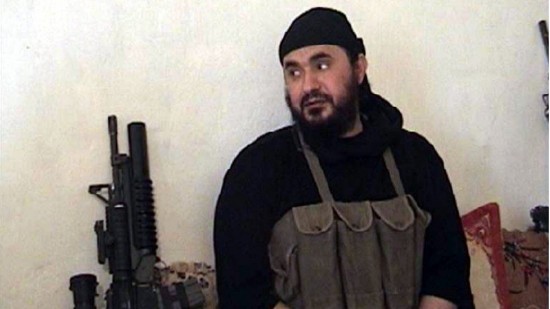
A high-school dropout whose prison career began with a sentence for drug and sexual offences, Zarqawi found religion after being sent to classes at a mosque in the Jordanian capital, Amman. He arrived in Pakistan to join jihad in Afghanistan just in time to see the Soviets withdraw in 1989, but stayed on to work with jihadists.
After a stint back in Jordan where he received a 15-year jail sentence on terrorist charges but was later released in a general amnesty, Zarqawi finally met Bin Laden and Ayman al-Zawahiri in 1999. By all accounts the two al-Qaeda leaders did not take to him. They found him brash and headstrong, and they did not like the many tattoos from his previous life that he had not been able to erase.
But he was charismatic and dynamic, and although he did not join al-Qaeda, they eventually put him in charge of a training camp in Herat, western Afghanistan. It was here that he worked with an ideologue whose radical writings became the scriptures governing subsequent salafist blood-letting: Abu Abdullah al-Muhajir.
"The brutality of beheading is intended, even delightful to God and His Prophet," wrote Muhajir in his book The Theology of Jihad, more generally referred to as the Theology of Bloodshed. His writings provided religious cover for the most brutal excesses, and also for the killing of Shia as infidels, and their Sunni collaborators as apostates.
The other book that has been seen as the virtual manual - even the Mein Kampf - for IS and its forebears is The Management of Savagery, by Abu Bakr Naji, which appeared on the internet in 2004.
"We need to massacre and to do just as has been done to Banu Qurayza, so we must adopt a ruthless policy in which hostages are brutally and graphically murdered unless our demands are met," Naji wrote. He was referring to a Jewish tribe in seventh-century Arabia which reportedly met the same fate at the hands of early Muslims as the Yazidis of Sinjar did nearly 14 centuries later: the men were slaughtered, the women and children enslaved.
Naji's sanctioning of exemplary brutality was part of a much wider strategy to prepare the way for an Islamic caliphate. Based partly on the lessons of Afghanistan, his book is a detailed blueprint for provoking the West into interventions which would further rally the Muslims to jihad, leading to the ultimate collapse of the enemy.
The scenario is not so fanciful if you consider that the Soviet Union went to pieces barely two years after its withdrawal from Afghanistan.
Naji is reported to have been killed in a US drone strike in Pakistan's Waziristan province in 2008.
Iraq fiasco
The fallout from the 9/11 attacks changed things radically for the jihadists in late 2001. The US and allies bombed and invaded Afghanistan, ousting the Taliban, and launching a wider "War on Terror" against al-Qaeda.
Bin Laden went underground, and Zarqawi and others fled. The dispersing militants, fired up, badly needed another battlefield on which to provoke and confront their Western enemies.
Luck was on their side. The Americans and their allies were not long in providing it.
Their invasion of Iraq in the spring of 2003 was, it turned out, entirely unjustified on its own chosen grounds - Saddam Hussein's alleged production of weapons of mass destruction, and his supposed support for international terrorists, neither of which was true.
By breaking up every state and security structure and sending thousands of disgruntled Sunni soldiers and officials home, they created precisely the state of "savagery", or violent chaos, that Abu Bakr Naji envisaged for the jihadists to thrive in.
Iraq was on the way to becoming what US officials are now calling the "parent tumour" of the IS presence in the region.
Under Saddam's tightly-controlled Baath Party regime, the Sunnis enjoyed pride of place over the majority Shia, who have strong ties with their co-religionists across the border in Iran.
The US-led intervention disempowered the Sunnis, creating massive resentment and providing fertile ground for the outside salafist jihadists to take root in.
They were not long in spotting their constituency. Abu Musab Zarqawi moved in, and within a matter of months was organising deadly, brutal and provocative attacks aimed both at Western targets and at the majority Shia community.
Doctrinal differences between the two sects go back to disputes over the succession to the Prophet Muhammad in the early decades of Islam, but conflict between them is generally based on community, history and sectarian politics rather than religion as such.
Setting himself up with a new group called Tawhid wa al-Jihad (Tawhid means declaring the uniqueness of Allah), Zarqawi immediately forged a pragmatic operational alliance with underground cells of the remnants of Saddam's regime, providing the two main intertwined strands of the Sunni-based insurgency: militant Jihadism, and Iraqi Sunni nationalism.
His group claimed responsibility for several deadly attacks in August 2003 that set the pattern for much of what was to come: a suicide truck bomb explosion at the UN headquarters in Baghdad that killed the envoy Sergio Vieira de Mello and 20 of his staff, and a suicide car bomb blast in Najaf which killed the influential Shia ayatollah Muhammad Baqir al-Hakim and 80 of his followers. The bombers were salafist jihadists, but logistics were reportedly provided by underground Baathists.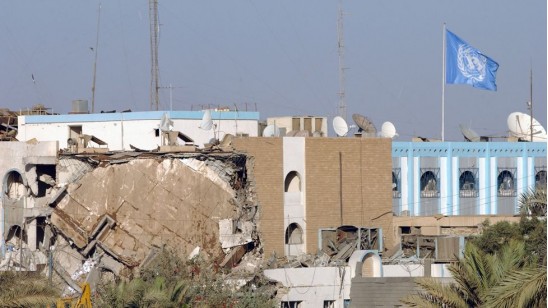
The following year, Zarqawi himself was believed by the CIA to be the masked killer shown in a video beheading an American hostage, Nicholas Berg, in revenge for the Abu Ghraib prison abuses of Iraqi detainees by members of the US military.
As the battle with the Americans and the new Shia-dominated Iraqi government intensified, Zarqawi finally took the oath of loyalty to Bin Laden, and his group became the official al-Qaeda branch in Iraq.
But they were never really on the same page. Zarqawi's provocative attacks on Shia mosques and markets, triggering sectarian carnage, and his penchant for publicising graphic brutality, were all in line with the radical teachings he had imbibed. But they drew rebukes from the al-Qaeda leadership, concerned at the impact on Muslim opinion.
Zarqawi paid little heed. His strain of harsh radicalism passed to his successors after he was killed by a US air strike in June 2006 on his hideout north of Baghdad. He was easily identified by the tattoos he had never managed to get rid of.
The direct predecessor of IS emerged just a few months later, with the announcement of the Islamic State in Iraq (ISI) as an umbrella bringing the al-Qaeda branch together with other insurgent factions.
But tough times lay ahead. In January 2007, the Americans began "surging" their own troops in Iraq from 132,000 to a peak of 168,000, adopting a much more hands-on approach in mentoring the rebuilt Iraqi army. At the same time, they enticed Sunni tribes in western al-Anbar province to stop supporting the jihadists and join the US-led Coalition-Iraqi government drive to quell the insurgency, which many did, on promises that they would be given jobs and control over their own security.
By the time both the new ISI and al-Qaeda leaders were killed in a US-Iraqi army raid on their hideout in April 2010, the insurgency was at its lowest ebb, pushed back into remote corners of Sunni Iraq.
They were both replaced by one man, about whom very little was publicly known at the time, and not much more since: Ibrahim Awad al-Badri, better known by his nom de guerre, Abu Bakr al-Baghdadi.
Six eventful years later, he would be proclaimed Caliph Ibrahim, Commander of the Faithful and leader of the newly declared "Islamic State".
Territorial takeover
Baghdadi's career is so shrouded in mist that there are very few elements of it that can be regarded as fact. By all accounts he was born near Samarra, north of Baghdad, so the epithet "Baghdadi" seems to have been adopted to give him a more national image, while "Abu Bakr" evokes the first successor to (and father-in-law of) Prophet Muhammad.
Like the original Abu Bakr, Baghdadi is also reputed to come from the Prophet's Quraysh clan. That, and his youth - born in 1971 - may have been factors in his selection as leader.
All accounts of his early life agree that he was a quiet, scholarly and devout student of Islam, taking a doctorate at the Islamic University of Baghdad. Some even say he was shy, and a bit of a loner, living for 10 years in a room beside a small Sunni mosque in western Baghdad.
The word "charismatic" has never been attached to him.
Who is the leader of IS?
As a youth, Baghdadi had a passion for Koranic recitation and was meticulous in his observance of religious law. His family nicknamed him The Believer because he would chastise his relatives for failing to live up to his stringent standards.
Who is Islamic State leader Abu Bakr al-Baghdadi?
But by the time of the US-led invasion in 2003, he appears to have become involved with a militant Sunni group, heading its sharia (Islamic law) committee. American troops detained him, and he was reportedly held in the detention centre at Camp Bucca in the south for most of 2004.
Camp Bucca (named after a fireman who died in the 9/11 attacks) housed up to 20,000 inmates and became a university from which many IS and other militant leaders graduated. It gave them an unrivalled opportunity to imbibe and spread radical ideologies and sabotage skills and develop important contacts and networks, all in complete safety, under the noses and protection of their enemies.
Baghdadi would also certainly have met in Camp Bucca many of the ex-Baathist military commanders with whom he was to form such a deadly partnership.
The low-profile, self-effacing Baghdadi rang no alarm bells with the Americans. They released him, having decided he was low-risk.
But he went on to work his way steadily up through the insurgent hierarchy, virtually unknown to the Iraqi public.
By the time Baghdadi took over in 2010, the curtains seemed to be coming down for the jihadists in the Iraqi field of "savagery".
But another one miraculously opened up for them across the border in neighbouring Syria at just the right moment. In the spring of 2011, the outbreak of civil war there offered a promising new arena of struggle and expansion. The majority Sunnis were in revolt against the oppressive regime of Bashar al-Assad, dominated by his Alawite minority, an offshoot of Shia Islam.
Baghdadi sent his men in. By December 2011, deadly car bombs were exploding in Damascus which turned out to be the work of the then shadowy al-Nusra Front. It announced itself as an al-Qaeda affiliate the following month. It was headed by a Syrian jihadist, Abu Mohammed al-Julani. He had been sent by Baghdadi, but had his own ideas.
Jostling with a huge array of competing rebel groups in Syria, al-Nusra won considerable support on the ground because of its fearless and effective fighting skills, and the flow of funds and foreign fighters that support from al-Qaeda stimulated. It was relatively moderate in its salafist approach, and cultivated local relationships.
Al-Nusra was slipping out of Baghdadi's control, and he didn't like it. In April 2013, he tried to rein it back, announcing that al-Nusra was under his command in a new Islamic State in Iraq and al-Sham (Syria or the Levant). Isis, or Isil, was born.
What's in a name?
During the short and turbulent period over which it has imposed itself as a major news brand, so-called Islamic State has confused the world with a series of name changes reflecting its mutations and changing aspirations, leaving a situation where there is no universal agreement on how to refer to it.
- After emerging in Iraq as the Islamic State in Iraq (ISI), its spread to Syria prompted the addition of "and al-Sham", a word that can mean Damascus, Syria, or the wider Levant
- Many chose to use the easy acronym Isis, with the "S" standing either for Syria or al-Sham, though the US administration and others opted for Isil (the "l" standing for "Levant"). Both are still widely used though technically outdated
- In Arabic the same acronym can come out as Daash, sometimes spelled Daesh in English; it has passed into common usage among many Arabs, but is disliked by the organisation itself, which sees it as disrespectful of the "state"; although Daash has no meaning in Arabic, it also has an unpleasant sound to it, which may be why American and Western officialdom often use it
- After further expansion of territory and ambitions, the movement dropped geographical specificity and called itself simply "the Islamic State"; Much of the world was politically reluctant simply to call it that, for fear of implying legitimacy
- The BBC and others have generally opted for calling it the "self-styled" or "so-called" Islamic State on first reference, and IS thereafter
But Julani rebelled, and renewed his oath of loyalty to al-Qaeda's global leadership, now under Ayman al-Zawahiri following Bin Laden's death in 2011. Zawahiri ordered Baghdadi to go back to being just the Islamic State in Iraq (ISI) and leave al-Nusra as the al-Qaeda Syria franchise.
It was Baghdadi's turn to ignore orders from head office.
Before 2013 was out, Isis and al-Nusra were at each other's throats. Hundreds were killed in vicious internecine clashes which ended with Isis being driven out of most of north-west Syria by al-Nusra and allied Syrian rebel factions. But Isis took over Raqqa, a provincial capital in the north-east, and made it its capital. Many of the foreign jihadists who had joined al-Nusra also went over to Isis, seeing it as tougher and more radical. In early 2014, al-Qaeda formally disowned Isis.
Isis had shaken off the parental shackles. But it had lost a lot of ground, and was bottled up. One of its main slogans, Remaining and Expanding, risked becoming empty. So where next?
Fortune smiled once more. Back in Iraq, conditions had again become ripe for the jihadists. The Americans had gone, since the end of 2011. Sunni areas were again aflame and in revolt, enraged by the sectarian policies of the Shia Prime Minister, Nouri Maliki. Sunnis felt marginalised, oppressed and angry.
When Isis decided to move, it was pushing at an open door. In fact, it had never really left Iraq, just gone into the woodwork. As it swept through Sunni towns, cities and villages with bewildering speed in June 2014, sleeper cells of salafist jihadists and ex-Saddamist militants and other sympathisers broke cover and joined the takeover.
With the capture of Mosul, Isis morphed swiftly into a new mode of being, like a rocket jettisoning its carrier. No longer just a shadowy terrorist group, it was suddenly a jihadist army not only threatening the Iraqi state, but challenging the entire world.
The change was signalled on 29 June by the proclamation of the "Islamic State", replacing all previous incarnations, and the establishment of the "caliphate". A few days later, the newly anointed Caliph Ibrahim, aka Abu Bakr al-Baghdadi, made a surprise appearance in Mosul in the pulpit of the historic Grand Mosque of Nour al-Din al-Zangi, heavily laden with anti-Crusader associations. He called on the world's Muslims to rally behind him.
By declaring a caliphate and adopting the generic "Islamic State" title, the organisation was clearly setting its sights far beyond Syria and Iraq. It was going global.
Announcing a caliphate has huge significance and resonance within Islam. While it remains the ideal, Bin Laden and other al-Qaeda leaders had always shied away from it, for fear of failure. Now Baghdadi was trumping the parent organisation, setting IS up in direct competition with it for the leadership of global jihadism.
A caliphate (khilafa) is the rule or rein of a caliph (khalifa), a word which simply means a successor - primarily of the Prophet Muhammad. Under the first four caliphs who followed after he died in 632, the Islamic Caliphate burst out of Arabia and extended through modern-day Iran to the east, into Libya to the west, and to the Caucasus in the north.
The Umayyad caliphate which followed, based in Damascus, took over almost all of the lands that IS would like to control, including Spain. The Baghdad-based Abbasid caliphate took over in 750 and saw a flowering of science and culture, but found it hard to hold it all together, and Baghdad was sacked by the Mongols in 1258.
Emerging from that, the Ottoman Empire, based in Constantinople (Istanbul), stretched almost to Vienna at its peak, and was also a caliphate, though the distinction with empire was often blurred. The caliphate was finally abolished by Ataturk in 1924.
So when Baghdadi was declared Caliph of the Islamic State, it was an act of extraordinary ambition. He was claiming no less than the mantle of the Prophet, and of his followers who carried Islam into vast new realms of conquest and expansion.
For most Islamic scholars and authorities, not to mention Arab and Muslim leaders, such claims from the chief of one violent extremist faction had no legitimacy at all, and there was no great rush to embrace the new caliphate. But the millennial echoes it evoked did strike a chord with some Islamic romantics - and with some like-minded radical groups abroad.
Four months after the proclamation, a group of militants in Libya became the first to join up by pledging allegiance to Baghdadi, followed a month later by the Ansar Beit al-Maqdis jihadist faction in Egypt's Sinai. IS's tentacles spread deeper into Africa in March 2015 when Boko Haram in Nigeria took the oath of loyalty. Within a year, IS had branches or affiliates in 11 countries, though it held territory in only five, including Iraq and Syria.
It was in those two core countries that Baghdadi and his followers started implementing their state project on the ground, applying their own harsh vision of Islamic rule.
To the outside world, deprived of direct access to the areas controlled by IS, one of the most obvious and shocking aspects of this was their systematic destruction of ancient cultural and archaeological heritage sites and artefacts.
Some of the region's best-known and most-visited sites were devastated, including the magnificent temples of Bel and Baalshamin at Palmyra in Syria, and the Assyrian cities of Hatra and Nimrud in Iraq.
It wasn't just famous archaeological sites that came under attack. Christian churches and ancient monasteries, Shia mosques and shrines, and anything depicting figures of any sort were destroyed, and embellishments removed even from Sunni mosques. Barely a month after taking over Mosul, IS demolition squads levelled the 13th Century shrine of the Imam Awn al-Din, which had survived the Mongol invasion.
All of this was absolutely in line with IS's puritanical vision of Islam, under which any pictorial representation or shrine is revering something other than Allah, and any non-Muslim structures are monuments of idolatry. Even Saudi kings and princes to this day are buried without coffins in unmarked graves.
By posting videos of many of these acts which the rest of the world saw as criminal cultural vandalism, IS also undoubtedly intended to shock. In that sense, it was the cultural equivalent of beheading aid workers.
And there was a more practical and profitable side to the onslaught on cultural heritage. In highly organised manner, IS's Treasury Department issues printed permits to loot archaeological sites, and takes a percentage of the proceeds.
That is just the tip of the iceberg of a complex structure of governance and control put in place as IS gradually settled into its conquests, penetrating into every aspect of people's lives in exactly the same way as Saddam Hussein's intelligence apparatus had done.
Captured documents published by Der Spiegel last year give some idea of the role of ex-Baathist regime men in setting up and running IS in a highly structured and organised way, with much emphasis on intelligence and security.
Residents of Sunni strongholds like Mosul and Falluja in Iraq, and Raqqa in Syria, found that IS operatives already knew almost everything about everybody when they moved in and took over in 2014.
At checkpoints, ID cards were checked against databases on laptops, obtained from government ration or employee registers. Former members of the security forces had to go to specific mosques to "repent", hand over their weapons and receive a discharge paper.
"At first, all they did was change the preachers in the mosques to people with their own views," said a Mosul resident who fled a year later.
"But then they began to crack down. Women who had been able to go bare-headed now had to cover up, first with the headscarf and then with the full face-veil. Men have to grow beards and wear short-legged trousers. Cigarettes, hubble-bubble, music and cafes were banned, then satellite TV and mobile phones. Morals police [hisba] vehicles would cruise round, looking for offenders."
A Falluja resident recounted the story of a taxi-driver who had picked up a middle-aged woman not wearing a headscarf. They were stopped at an IS checkpoint, the woman given a veil and allowed to go, while the driver was sent to an Islamic court, and sentenced to two months' detention and to memorise a portion of the Koran. If you fail to memorise, the sentence is repeated.
"They have courts with judges, officials, records and files, and there are fixed penalties for each crime, it's not random," said the Falluja resident. "Adulterers are stoned to death. Thieves have their hands cut off. Gays are executed by being thrown off high buildings. Informers are shot dead, Shia militia prisoners are beheaded."
An activist based in Raqqa from a group called Al-Sharqiya 24 has been keeping a diary of what life is like under Islamic State group rule.
Life under 'Islamic State': Diaries
There are IS departments that carry the organisation's grip into every corner of life, including finance, agriculture, education, transport, health, welfare and utilities.
School curricula were overhauled in line with IS precepts, with history rewritten, all images being removed from schoolbooks and English taken off the menu.
"One thing you can say is this," said the Mosul resident. "There is absolutely no corruption, no wasta (knowing the right people and pulling strings). They are totally convinced they are on the right track."
One recent story tells a lot about IS and its ways.
As Iraqi security forces were pressing forward in areas around Ramadi earlier this year, civilians were fleeing the battle - and IS fighters, losing the day, were trying to sneak out too.
Two women, running from the combat zone, approached a police checkpoint.
As they were being waved through to safety, one of the women suddenly turned to the police, pointed at the other, and said : "This is not a woman. He's an IS emir [commander]."
The police investigated, and it was true. The other woman was a man, who had shaved, and put on makeup and women's clothes. He turned out to be top of the list of wanted local IS commanders.
"When IS arrived, he killed my husband, who was a policeman, raped me, and then took me as his wife," the woman told the police.
"I put up with him all this time, waiting to avenge my husband and my honour," she said. "I tricked him into shaving and putting on makeup, then denounced him to the police."
What is life like for women under IS?
"Nour" is a woman from Raqqa, the so-called Islamic State's (IS) capital inside Syria. She managed to escape the city and is now a refugee in Europe, where she met up with the BBC.
This story is based on her experiences and those of her two sisters, who are still inside the IS-held city.
Taking on the world
Having taken over vast swathes of territory in Iraq with their lightning offensive in June 2014, the militants might have been expected to calm down and consolidate their gains.
But, like a shark that has to keep moving or else it will die, IS barely paused before initiating a new spiral of provocation and reprisals that was predictably to draw it into active conflict with almost all the major world powers.
Already, the June offensive had threatened the approaches to Baghdad, prompting the Americans to start bringing in hundreds of military advisers and trainers to see how to help the struggling Iraqi army.
Just two months later, the attack on Kurdish areas in the north triggered US air strikes in defence of the Kurdistan capital, Irbil, and then to help stave off the threat of genocide to the Yazidis. Fourteen other nations were to join the air campaign.
Ten days later, IS beheaded James Foley and the others followed, in line with the doctrine of exemplary brutality as punishment, deterrent and provocation. The most shocking was to come some months later, with the burning alive of the downed Jordanian pilot Moaz al-Kasasbeh. Shock intended.
The US-led bombing campaign was extended to Syria in September 2014 after IS besieged the Kurdish-held town of Kobane on the Turkish border. Coalition air strikes turned the tide there. IS lost hundreds of fighters killed at Kobane and elsewhere. More revenge was called for. IS turned abroad.
From the declaration of the caliphate until early 2016, some 70 terrorist attacks were either carried out or inspired by IS in 20 countries around the globe, from California to Sydney, with an estimated 1,200 victims killed. The attacks carried the same message of punishment, deterrence and provocation as the hostage beheadings, while also demonstrating IS's global reach.
At the same time, they carried through the militants' doctrine of distracting the enemy by setting fires in different locations and making him squander resources on security. For IS, "the enemy" is everybody who does not embrace it. The world is divided into Dawlat al-Islam, the State of Islam, and Dawlat al-Kufr, the State of Unbelief.
The most consequential of these atrocities were the downing of a Russian airliner over Sinai on 31 October and the Paris attacks on 13 November, provoking both Russia and France to intensify air strikes on IS targets in Syria.
Had IS gone mad? It seemed determined to take on the whole world. It was goading and confronting the Americans, the Russians, and a long list of others. By its own count, it had a mere 40,000 fighters at its command (other estimates go as low as half that).
Could it really challenge the global powers and hope to survive? Or can President Barack Obama fulfil his pledge to "degrade and ultimately destroy" IS?
Final showdown
If there seems to be something apocalyptic about IS's "bring it on" defiance, that's because there is.
When the organisation first brought out its online magazine - a major showcase and recruitment tool - just a month after the "caliphate" was declared, it was not by chance that it was named Dabiq.
A small town north of Aleppo in Syria, Dabiq is mentioned in a hadith (a reported saying of the Prophet Muhammad) in connection with Armageddon. In IS mythology, it is the scene where a cataclysmic showdown will take place between the Muslims and the infidels, leading to the end of days. Each issue of Dabiq begins with a quote from Abu Musab Zarqawi: "The spark has been lit here in Iraq, and its heat will continue to intensify - by Allah's permission - until it burns the crusader armies in Dabiq."
The prospect of taking part in that final glorious climax, achieving martyrdom on the path of Allah and an assured place in paradise, is one of the thoughts inspiring those heeding the IS call to jihad.
That could help explain why the organisation seems to enjoy an endless supply of recruits willing to blow themselves to pieces in suicide attacks, which it calls "martyrdom-seeking operations" (suicide is forbidden in Islam). Hundreds have died in this way, and they happen virtually daily.
It's one of the elements that makes IS a formidable fighting force that will be hard to destroy even in strictly military terms.
The Baathist legacy at the core of IS
IS is in many respects a project of former Iraqi President Saddam Hussein's outlawed Baath party, but now with a different ideology. Former agents or officers of Saddam Hussein's regime dominate its leadership... They represent a battle-hardened and state-educated core that would likely endure (as they have done through US occupation and a decade of war) even if the organisation's middle and lower cadres are decimated.
Is Islamic State invincible?
The head of security and intelligence for the Kurdistan Regional Government (KRG) in northern Iraq, Masrour Barzani, tells the story of a frustrated would-be suicide bomber who screamed at his captors: "I was just 10 minutes away from being united with the Prophet Muhammad!"
"They think they're winners regardless of whether they kill you or they get killed," says Barzani. "If they kill you, they win a battle. If they get killed, they go to heaven. With people like this, it's very difficult to deter them from coming at you. So really the only way to defeat them is to eliminate them."
Probably for the first time in military history since the Japanese kamikaze squadrons of World War Two, suicide bombers are used by IS not only for occasional terrorist spectaculars, but as a standard and common battlefield tactic.
Virtually all IS attacks begin with one or several suicide bombers driving explosives-rigged cars or trucks at the target, softening it up for combat squads to go in. So much so that the "martyrdom-seekers" have been called the organisation's "air force", since they serve a similar purpose.
Formidable though that is, IS as a fighting force is much more than a bunch of wild-eyed fanatics eager to blow themselves up. For that, they have Saddam Hussein to thank.
"The core of IS are former Saddam-era army and intelligence officers, particularly from the Republican Guard," said an international intelligence official. "They are very good at moving their people around, resupply and so on, they're actually much more effective and efficient than the Iraqi army are. That's the hand of former military staff officers who know their business."
"They are very professional," adds Masrour Barzani. "They use artillery, armoured vehicles, heavy machinery etc, and they are using it very well. They have officers who know conventional war and how to plan, how to attack, how to defend. They really are operating on the level of a very organised conventional force. Otherwise they'd be no more than a terrorist organisation."
The partnership with the ex-Baathists, going back to Zarqawi's early days in Iraq, is clearly a vital component in IS success.
But that does not mean its fighters are invincible on the battlefield. The Kurds in north-east Syria were fighting IS off with no outside help for a year before anybody noticed. And even now, IS makes what would conventionally be seen as costly mistakes.
In December 2015, they lost several hundred fighters in one abortive attack east of Mosul alone, and probably 2,500 altogether that month. In total some 15,000 are estimated to have been killed by Coalition air strikes since August 2014.
But they seem to have little difficulty making up the numbers. With a population of perhaps 10 million acquiescent Sunnis to draw on in Iraq and Syria, most recruiting is done locally. And if IS remains in place, there will soon be a new generation of young militants.
"I didn't join out of conviction," says Bakr Madloul, a 24-year-old bachelor who was arrested in December at his home in a Sunni quarter in southern Baghdad and accused of taking part in deadly IS car bomb attacks on mainly Shia areas, which he admits.
Bakr says he was working as a construction foreman in Kurdistan when IS took over Mosul. He was detained for questioning by Kurdish security, and met a militant in jail who persuaded him to go to Mosul, where he joined up with IS and manned a checkpoint until it was hit by a Coalition air strike.
He was then sent back to his Baghdad suburb to help organise car bombings. The explosives-packed vehicles were sent from outside Baghdad, and his job was to place them where he was told by his controller, usually in crowded streets or markets.
"Only one of the five car bombs I handled was driven by a suicide bomber," he says. "I spoke to him. He was 22 years old, an Iraqi. He believed he would go to paradise when he died. It's the easiest and quickest way to Heaven. They strongly believe this. They would blow themselves up to get to Heaven. There were older ones in their 30s and 40s."
"I asked my controllers more than once, 'Is it OK to kill women and children?' They would answer, 'They're all the same.' But to me, killing women and children, I didn't feel at all comfortable about that. But once you're in, you're stuck. If you try to leave, they call you a murtadd, an apostate, and they'll kill you or your family."
Bakr knows he will almost certainly hang. I asked him if he would do the same things over if he had his life again. He laughed.
"Absolutely not. I would get out of Iraq, away from IS, away from the security forces. I took this path without realising the consequences. There is no way back. I see that now."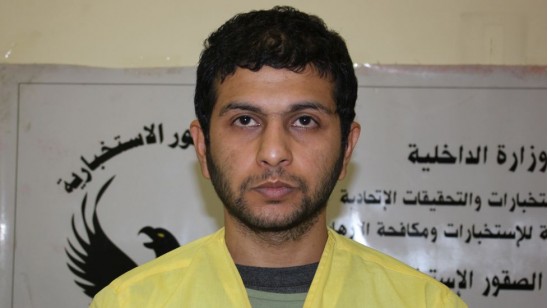
But up in Kurdistan, another IS prisoner, Muhannad Ibrahim, has no such regrets.
A 32-year-old from a village near Mosul with a wife and three children, he was a construction worker for a Turkish company when IS took over the city. Two of his older brothers had died fighting the Americans there in 2004 and 2006. He joined IS without hesitation and was commanding a small detachment when he was captured in a battle with the Kurds.
"We were being oppressed by the Shia, they were always insulting and bothering us," he says. "But that's not the main motivation, religious conviction is more important. All my family is religious, praise be to Allah. I came to IS through my faith and religious principles."
"If I had my time over again, I would take the same path, the same choices. Because I am convinced by this thing, I have to go to the end. Either I am killed, or Allah will decree some other fate for me."
Taming Mosul
Defeating IS militarily is less about its own strengths and vulnerabilities than it is about the deficiencies of the forces arrayed against it. IS is as strong as the weaknesses of the failed states whose collapse into "savagery" has left room for it to take root and grow.
Iraq and Syria have to be the primary focus, as the commander of Coalition forces, Lt Gen Sean MacFarland, spelled out in February 2016:
"The campaign has three objectives: one, to destroy the Isil parent tumour in Iraq and Syria by collapsing its power centres in Mosul and Raqqa; two, to combat the emerging metastasis of the Isil tumour worldwide; and three, to protect our nations from attack."
It goes without saying that Coalition air strikes, deadly and effective as they are, have their limitations. Only in co-ordination with cohesive, motivated ground forces can the territory taken by IS be regained. And that's the crippling problem, in both countries.
All of which does not augur well for the sound retrieval of remaining Sunni hotbeds where IS is dug in in Iraq, such as Falluja - barely 30 miles from Baghdad - and above all, Mosul, 10 times the size of Ramadi.
Surprisingly, given the presence of literally hundreds of competing rebel factions, it's in Syria that the chances of making serious progress against IS may be greater, though still not great.
The IS imperative has spurred all the outside parties involved there, including the Americans and the Russians and their regional and local allies, for the first time to put serious weight behind a truce and a negotiated settlement between rebels and regime.
The idea and driving motive is that all parties would then be free to turn on IS, and, to be consistent, also al-Nusra Front, because it belongs to al-Qaeda. It may seem like a long shot, but the US seems to be pushing very hard indeed, making things happen that have proven intractable for nearly five years.
If all the parties - the rebel groups, the Kurds, regime troops and militias, and their outside allies including the Coalition and the Russians - can somehow be reconciled and turned against IS, its chances of surviving for long in Syria would not be great.
Its only real conurbation there is Raqqa. It is much less deeply embedded in the Sunni population in Syria than in Iraq. Disgruntled Syrian Sunnis have many other vehicles for pressing their grievances against the regime.
So it keeps coming back again to Iraq, and specifically, to Mosul. Ten times the size of Raqqa. And that's not the only reason for its significance.
"Mosul is the beating heart of IS," says a senior Western official in northern Iraq. "IS is essentially an Iraqi creation. The tragic reality is that at the moment, it is the main Sunni political entity in Iraq. From the West, it's looked at as a kind of crazed cult. It's not. Here in Iraq it represents an important constituency. It represents a massive dissatisfaction, the alienation of a whole sector of the population."
"That's not to say that the people in Mosul are enthusiastic about IS, but for them, it's better than anything that comes from Baghdad."
The word in both Baghdad and northern Iraq is that the Americans are pushing seriously hard for a Mosul campaign by the end of 2016, with President Obama's departure in mind. That may not be possible, given the difficulties involved in assembling credible ground forces, as well as severe financial crises affecting both Baghdad and Kurdistan.
But if it does go ahead, the fear is that wrongly-conceived short-term victory, if it is achieved, will turn into long-term disaster, given the total lack of national reconciliation between Sunnis and Shia in the wake of the sectarian carnage that followed Saddam's overthrow in 2003.
Sunni grievances in Iraq are such that if IS did not exist, it would have to be invented. Without reconciliation and a sense of Sunni empowerment and partnership in a national project, IS in some shape or form will always be there, just as the Taliban are now resurgent in Afghanistan despite everything that was done to oust them.
But the Iraqi expert on radical movements, Hisham al-Hashemi, believes that IS could be badly damaged if the Coalition succeed in one of their top-priority tasks - to kill Abu Bakr Baghdadi.
Leaders have been killed before, and replaced with little obvious effect on the course of history. But Hashemi believes Baghdadi is different.
"IS's future depends on Baghdadi," he says. "If he is killed, it will split up. One part would stay on his track and announce a new caliphate. Another would split off and return to al-Qaeda. Others would turn into gangs following whoever is strongest."
"The source of his strength is that he brought about an ideological transformation, blending jihadist ideas with Baathist intelligence security methods, enabling him to create this quasi-state organisation."
Hashemi believes only Baghdadi can hold it together. There have been numerous false reports of him being hit, but he appears to be stubbornly and elusively still alive, not seen in public since that mosque appearance in early July 2014.
The Americans are unlikely to rest until they have killed Baghdadi, not least because of their belief that he personally repeatedly raped an American NGO worker, Kayla Mueller, and then had her killed in early 2015.
But even if they do get him, and even if IS does break up, the Sunni problem in Iraq will not go away.
Capitalising on chaos
IS is in any case spreading its bets and developing other territorial options. At present, Libya looks the most promising. It has just the kind of failed-state anarchy, the "savagery", that leaves room for the jihadists to move in, forging alliances with local militants and disgruntled supporters of the overthrown regime. Just like Iraq.
IS signalled its arrival there in typical style, issuing a polished video in February 2015 showing a group of 21 bewildered Egyptian Christian workers in orange jumpsuits being beheaded on a Libyan beach, their blood mingling with the waters of the Mediterranean as a warning to the "crusader" European countries on the other side.
The man who voiced that warning was believed to be the IS leader in Libya, an Iraqi called Wissam al-Zubaydi, aka Abu Nabil. By coincidence, Zubaydi was killed in a US air strike on the same day IS struck terror in Paris, 13 November 2015.
The man sent by IS to replace him, Abu Omar al-Janabi, was another Iraqi and former Baathist with a tough reputation and a knack for generating revenue - clearly with one eye on Libya's oil facilities, given the damage wrought by Coalition bombing on the organisation's exploitation of fields in Iraq and Syria.
The US and allies have been powerless to halt IS advances in Libya, taking over a big stretch of the coast around the central city of Sirte, which was to (overthrown) Libyan leader Muammar Gaddafi what Tikrit was to Saddam Hussein. Another American air strike in February killed (among nearly 50 other people) Noureddine Chouchane, reputedly an IS figure responsible for the deadly attacks on Western tourists in his native Tunisia next door.
With little prospect of a national unity government to end Libya's chaotic fragmentation and provide partners on the ground, such remote strikes - which sometimes act as powerful recruiters for the militants - are about all the frustrated Western powers can do as IS takes root and spreads.
There are other possibilities already beckoning - Yemen, Afghanistan, Pakistan, Somalia... wherever there are dysfunctional states and angry Muslims, there are opportunities for IS, competing strongly with a diminished al-Qaeda as a dominant brand in the jihadist market. Adding the extra risk for the West, that that competition could be another spur for spectacular terrorist attacks which they know are being actively plotted.
Battle for minds
In the first 18 months after the declaration of the "Islamic State", the number of foreign fighters making their way to join jihad in Syria and Iraq rose dramatically. The New York-based security consultancy Soufan Group estimated that 27,000 foreign jihadists had made the trip from 86 countries, more than half of them from the Middle East and North Africa.
Clearly, the caliphate had appeal, despite - perhaps in some cases because of - its graphically publicised brutality. A tribute to its extraordinary skill in using the internet and social media as a propaganda and grooming tool.
Ten months after vowing to "degrade and ultimately destroy" the organisation, President Obama ruefully acknowledged that IS "has been particularly effective at reaching out to and recruiting vulnerable people around the world including here in the United States, and they are targeting Muslim communities around the world".
And he put his finger on the real challenge, monumentally greater than the comparatively simple task of defeating IS militarily:
"Ideologies are not defeated with guns, they are defeated by better ideas, a more attractive and more compelling vision," he said.
The complex art of IS propaganda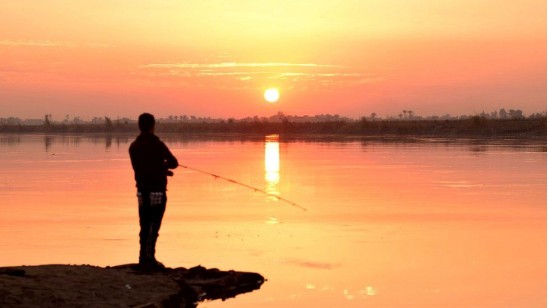
The problem is that when disenchanted people in the region look around them - especially the young, the idealistic, or the hopeless unemployed who have no future - they see scant evidence of "better ideas" or attractive and compelling visions.
They see the ruins of an "Arab Spring" which raised hopes only to dash them cruelly.
The brutal, corrupt dictatorships which it shook have either fragmented into chaos and sectarian and tribal upheaval, like Syria itself, Libya, Yemen and (with Western intervention) Iraq, or the "deep states" of their former regimes came back, even more harshly in the case of Egypt, more gently in the case of Tunisia.
While many of the European jihadists may have heeded the call for other reasons, socio-economic factors play an important part in radicalising some of the Arab jihadists, and will continue to do so unless addressed.
Why IS still attracts recruits from Europe
The flow of recruits, both fighters and families, leaving their homes in Europe to live under so-called Islamic State rule in Raqqa in Syria has slowed dramatically.
"It reached its peak in 2013-14, when it was far easier for jihadists to cross the 822km-long (510-mile) Turkey-Syria border, when IS propaganda on social media went largely unchallenged, and when IS was on a roll militarily, seizing ever more territory across northern Syria and north-western Iraq.
"While all three of those factors have now changed to the detriment of IS, the underlying factors propelling young Britons and
Europeans towards joining the group have not gone away. So what are they?
Islamic State: What is the attraction for young Europeans?
One of the biggest contingents is from Tunisia, where a detailed survey in the poorest suburbs of the capital showed clearly that the radicalisation of young people there had far less to do with extreme Islamic ideology as such than it did with unemployment, marginalisation and disillusion after a revolution into which they threw themselves, but which gave them nothing, and left them hopeless.
A rare insight into the types of people who volunteer to join IS came with the emergence in European media in March of batches of what are believed to be "secret" IS files with personal details of recruits.
The data from 2013-14 purported to identify members from at least 40 countries. It included names, addresses, phone numbers and skill sets - a potential treasure trove for intelligence agencies trying to track and prosecute nationals who have signed up with the group.
IS is also filling a desert left by the collapse of all the political ideologies that have stirred Arab idealists over the decades. Many used to travel to the Soviet Union for training and tertiary education, but communism is now seen as a busted flush. Arab socialism and Arab nationalism that caused such excitement in the 1950s and 1960s mutated into brutal, corrupt "republics" where sons were groomed to inherit power from their fathers.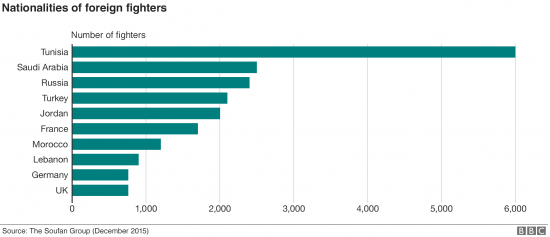
In this vacuum, IS took up the cause of punishing the West and other outsiders for their actions in the region over the past century:
the carve-up by the colonial powers 100 years ago, drawing a border between Iraq and Syria which IS has now erased
the creation of Israel under the British mandate for Palestine, and its subsequent unswerving political and financial support by the US
Western (and indeed Russian) backing for corrupt and tyrannical Arab regimes
the Western invasion and destruction of Iraq on the flimsiest of pretexts, with the death of uncounted thousands of Iraqis
the Abu Ghraib and Guantanamo prisoner abuse scandals....
The roots of IS also lie in a crisis within Islam.
"Isil is not Islamic," said President Obama, echoing statements by many Western leaders that "IS has nothing to do with Islam".
It has.
"It is based on Islamic texts that are reinterpreted according to how they see it," says Ahmad Moussalli, professor of politics at the American University of Beirut. "I don't say they are not coming out of Islamic tradition, that would be denying facts. But their interpretation is unusual, literal sometimes, very much like the Wahhabis."
Hisham al-Hashemi, the Iraqi expert on radical groups, agrees.
"Violent extremism in IS and the salafist jihadist groups is justified, indeed blessed, in Islamic law texts relied on by IS and the extremist groups. It's a crisis of religious discourse, not of a barbaric group. Breaking up the religious discourse and setting it on the right course is more important by far than suppressing the extremist groups militarily."
Because ancient texts can be interpreted by extremists to cover their worst outrages does not implicate the entire religion, any more than Christianity is defined by the Inquisition, where burning at the stake was a stock penalty.
Extremist ideas remain in the dark, forgotten corners of history unless their time comes. And IS time came, with Afghanistan, Iraq, and everything that followed.
"Salafism is spreading in the world, in Afghanistan, Pakistan, the Arab countries," says Prof Moussalli.
He blames the Saudis for stifling the emergence of a moderate, democratic version of Islam, the "alternative Islamic discourse" to salafism that President Obama would like to see.
"A moderate Islamic narrative today is a Muslim Brotherhood narrative, which has been destroyed by the Gulf states supporting the military coup in Egypt," says Prof Moussalli, referring to the Egyptian military's ousting of the elected President Mohammed Morsi, a senior Muslim Brotherhood figure, in July 2013.
"We lost that opportunity with Egypt. Egypt could have paved the way for real change in the area. But Saudi Arabia stood against it, in a very malicious way, and destroyed the possibility of changing the Arab regimes into more democratic regimes that accept the transfer of power peacefully. They don't want it."
Saudi Arabia's ultra-conservative Wahhabi religious establishment and its constant propagation have raised ambiguity over its relations with radical groups abroad. Enemies and critics have accused it of producing the virulent strain of Wahhabism that inspires the extremists, and even of supporting IS and other ultra-salafist groups.
But Jamal Khashoggi, a leading Saudi journalist and writer who spent time in Afghanistan and knew Bin Laden, says that simply is not true
"We are at war with IS, which sees us as corrupt Wahhabis." he says.
"IS is a form of Wahhabism that has been suppressed here since the 1930s. It resurfaced with the siege of the Grand Mosque in Mecca in 1979 and spread here and there. But Saudi Arabia didn't back it at all, it saw it as a threat. So it's true that salafism can turn radical, just as the US right-wing produces some crazy lunatics."
Hundreds of people died in a two-week siege when extremist salafists took over the Grand Mosque, the holiest place in Islam, in protest at what they saw as the Kingdom's deviation from the true path.
More recently, Saudi Arabia's security forces and its Shia minority have in fact been the target of attacks by IS, and the kingdom has executed captured militants. It has an active deradicalisation programme.
But Mr Khashoggi agrees that the Saudis made a huge mistake when they backed the overthrow of the elected Muslim Brotherhood president in Egypt and the subsequent crackdown on the movement, which has pushed political Islam into the arms of the radicals.
"There were no pictures of Isis, Bin Laden or al-Qaeda in Tahrir Square," he says. "It was an opportunity for democracy in the Middle East, but we made a historical blunder for which we are all paying now."
But the Kingdom's extreme conservatism, its distaste for democracy, and its custodianship of the shrines in Mecca and Medina to which millions of Muslims make pilgrimage every year, have made it one of the main targets for calls for an unlikely reformation within Islam as part of the battle to defeat IS and other extremist groups.
"We must accept the fact that Islam has a crisis," says a senior Sunni politician in Iraq.
"IS is not a freak. Look at the roots, the people, the aims. If you don't deal with the roots, the situation will be much more dangerous. The world has to get rid of IS, but needs a new deal: reformation, in Saudi Arabia, Afghanistan, al-Azhar [the ancient seat of Sunni Islamic learning and authority in Cairo]."
"You can't kill all the Muslims, you need an Islamic reformation. But Saudi and Qatari money is blotting out the voices so we can't get anywhere. It's the curse of the Arab world, too much oil, too much money."
Regional rivalry
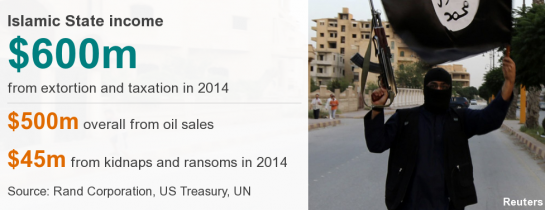
IS is at the heart of yet another of the region's burning themes - the strategic geopolitical contest, the game of nations, that is taking place as Syria and Iraq disintegrate.
When the US-led coalition destroyed the Iraqi state in 2003, it was breaking down the wall that was containing Iran, the region's Shia superpower, seen as a threat by the Saudis and most of their Sunni Gulf partners since its Islamic revolution in 1979.
Iran had for years been backing anti-Saddam Iraqi Shia factions in exile. Through those groups, the empowerment of the majority Shia community in Iraq after 2003 gave Iran unrivalled influence over Iraqi politics.
The arrival of the IS threat led to even more Iranian penetration, arming, training and directing the Shia militia who rose in defence of Baghdad and the South.
"If it weren't for Iran, the democratic experiment in Iraq would have fallen," says Hadi al-Ameri, leader of the Iranian-backed Badr Organisation, one of the biggest Shia fighting groups.
"Obama was sleeping, and he didn't wake up until IS was at the gates of Erbil. When they were at the gates of Baghdad, he did nothing. Were it not for Iran's support, IS would have taken over the whole Gulf, not just Iraq."
For Saudi Arabia and its allies, Iranian penetration in Iraq threatens to establish, indeed largely has, a Shia crescent, linking Iran, Iraq, Syria under its minority Alawite leadership, and Lebanon dominated by the Iranian-created Shia faction Hezbollah.
From the outset of the war in Syria, the Saudis and their Gulf partners, and Turkey, backed the Sunni rebels in the hope that the overthrow of Assad would establish Sunni majority rule.
So then a north-south Sunni axis running from Turkey through Syria to Jordan and Saudi Arabia would drive a stake through the heart of the Shia crescent and foil the Iranian project, as they saw it.
That is essentially what IS did in 2014 when it moved back into Iraq, took Mosul and virtually all the country's Sunni areas, and established a Sunni entity which straddled the suddenly irrelevant border with Syria, blocking off Shia parts of Iraq from Syria.
If IS had just stayed put at that point and dug in, who would have shifted them? Had they not gone on to attack the Kurds, the Americans would not have intervened. Had they not shot down a Russian airliner and attacked Paris, the Russians and French would not have stepped up their involvement.
"Had they not become international terrorists and stayed local terrorists, they could have served the original agenda of dividing the Arab east so there would be no Shia crescent," says Prof Moussalli.
We may never know why they did it. Perhaps their virulent strain of salafism just had to keep going: Remaining and Expanding.
Could they now just row back and settle in their "state", stop antagonising people, and eventually gain acceptance, just as Iran has after its own turbulent revolution and international isolation?
It seems unlikely, for the same driving reasons that they made that escalation in the first place. And even if IS wanted to, the Americans also seem set on their course, and they have proven implacable in their pursuit of revenge for terrorist outrages.
But what is the alternative? Given the problem of assembling capable ground forces, can the Americans be complicit in a takeover of Mosul by Iranian-backed Shia militias, and of Raqqa by Russian- and Iranian-backed Syrian regime forces or other non-Sunni groups like the Kurds? Is their hostility to IS so strong that they would watch the Iranians connect up their Shia crescent? And would the Saudis and Turks go along with that?
There are no easy answers to any of the challenges posed by IS in all the strands of crisis that it brings together.
That's why it's still there.
Credits:
Author: Jim Muir
Editor: Raffi Berg
Production: Ben Milne, Susannah Stevens
Graphics: Henry Clarke Price













